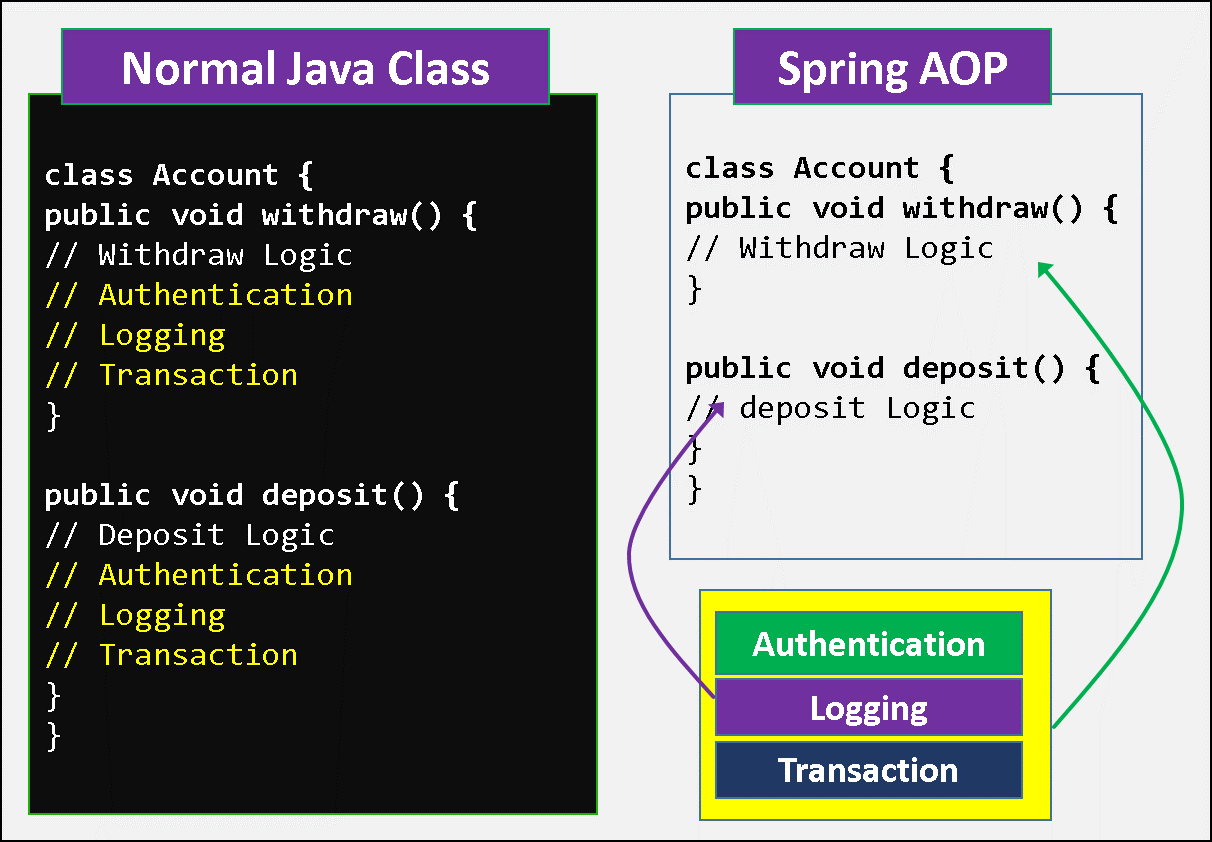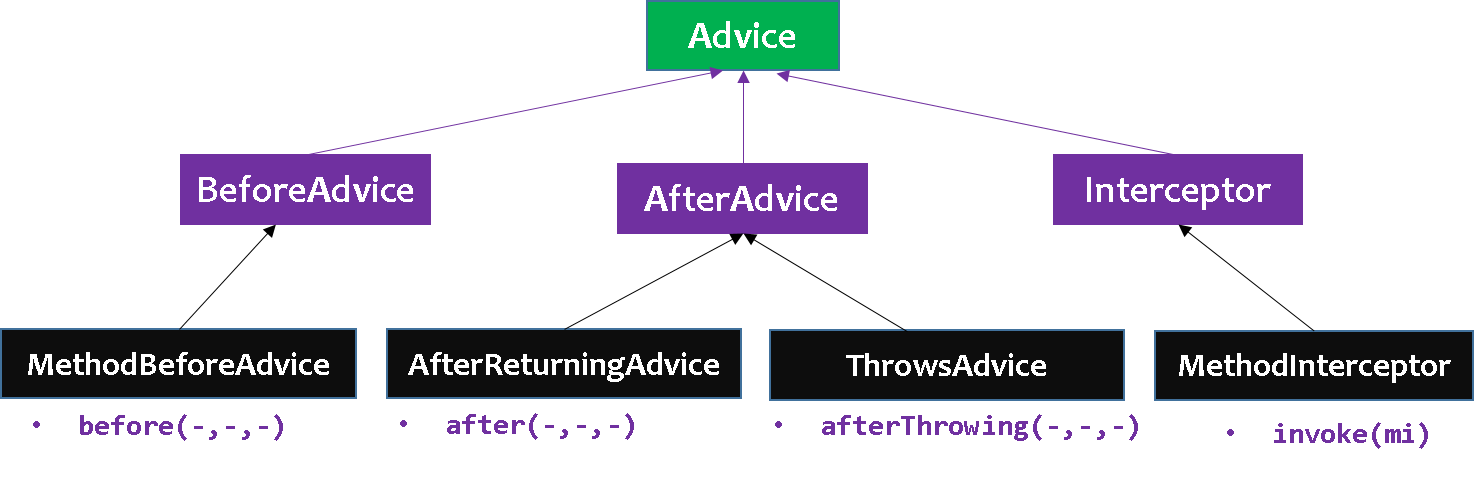Spring AOP
Spring AOP (Aspect-oriented programming) framework is used for adding different cross-cutting functionalities. cross-cutting functionalities means adding different types of services to the application at runtime automatically.
In below Account class, we have withdraw() & deposit() methods each have Authentication, Logging, Trasaction cross-cutting functionalities. These are repeating in same class & also if we have 50 methods, we have to write these functionalities in 50 methods so, code is repeating.

In order to overcome the above problems, we need to separate the business logic and the services, is known as AOP, Using AOP the business logic and cross-cutting functionalities are implemented separately and executed at run time as combine.
AOP is a Specification, Spring framework is implemented it. AOP implementations are provided by
- Spring AOP, AspectJ, JBoss AOP
AOP Terminology
We use these 9 terminilogies very common on Spring AOP
-
Aspect
-
Advice
-
JoinPoint
-
Pointcut
-
Introduction
-
Target
-
Proxy
-
Weaving
-
Adviser
1. Aspect
-
An aspect represents the cross-cutting functionality name, just name only.
-
Aspect denotes only the cross-cutting functionality name not its implementation
-
In above, we have 3 Aspects: Authentication Aspect, Logging Aspect, Transaction Aspect.
2. Advice
-
Advice is the implementation of Aspect.
-
An Advice provides the code for implementation of the service.
-
The Implementation of above aspects called as Authentication Advice, Logging Advice, Transaction Advice.

In Spring AOP we have 4 Types of Advices
1.Before Advice
-
services will be applied before business logic
-
MethodBeforeAdvice **interface extends the BeforeAdvice interface.**
-
If we implement MethodBeforeAdvice interface, we need to override before() method.
-
before() method are executed at before business logic
public class beforeAdvice implements MethodBeforeAdvice { public void before(Method m,Object args[], Object target)throws Exception { //My Before Logic... } }
2.After Advice
-
services will be applied After business logic
-
AfterReturningAdvice **interface extends the AfterAdvice interface.**
-
we need to override afterReturning() method
public class afterAdvice implements AfterReturningAdvice { public void afterReturning(Object retnVal,Object args[], Object target)throws Exception { //My Before Logic... } }
3.Around Advice
-
It is the combination of both Before and After Advice.
-
MethodInterceptor interface extends the Interceptor interface.
-
In Around Advice, we implement Before and After Advice in a single method called invoke(), in order to separate Before an After services to execute business logic, in the middle we call proceed() method
public class Client implements MethodInterceptor { public Object invoke(MethodInvocation mi)throws Throwable { //Before Logic Object ob = mi.proceed(); //After logic return ob; } }
4.Throws Advice
-
services will be applied when business logic methods throws an exception.
-
ThrowsAdvice interface also extends the AfterAdvice interface.
-
we should implement **afterThrowing() **method
public class Client implements ThrowsAdvice { public void afterThrowing(Method m,Object args[],Object target,Exception e) { // our services } }
3. JoinPoint
While creating the business logic of the method the additional services are needed to be injected at different places or points, we call such points as joinpoints. At a joinpoint a new service will be added into the normal flow of a business method.
While executing the business method, the services are required at the following 3 places, we call them as JoinPoints.
-
Before business logic of the method starts
-
After business logic of the method got completed
-
If business logic throws an exception at run time
4. Pointcut
A pointcut defines what advices are required at what join points. In above diagram Authentication Advice, Logging Advice, Transaction Advice are required after withdraw logic & after balance logic. So this point is known as PointCut.
5. Introduction
It means introduction of additional method and fields for a type. It allows you to introduce new interface to any advised object.
6. Target Object
It is the object i.e. being advised by one or more aspects. It is also known as proxied object in spring because Spring AOP is implemented using runtime proxies.
7. Aspect
It is a class that contains advices, joinpoints etc.
8. Interceptor
It is an aspect that contains only one advice.
9. AOP Proxy
It is used to implement aspect contracts, created by AOP framework. It will be a JDK dynamic proxy or CGLIB proxy in spring framework.
10. Weaving
It is the process of linking aspect with other application types or objects to create an advised object. Weaving can be done at compile time, load time or runtime. Spring AOP performs weaving at runtime.
Spring AOP can be used by 3 ways given below. But the widely used approach is Spring AspectJ Annotation Style. The 3 ways to use spring AOP are given below:
-
By Spring1.2 Old style (dtd based)
-
By AspectJ : annotation-style
-
By AspectJ : XML configuration-style